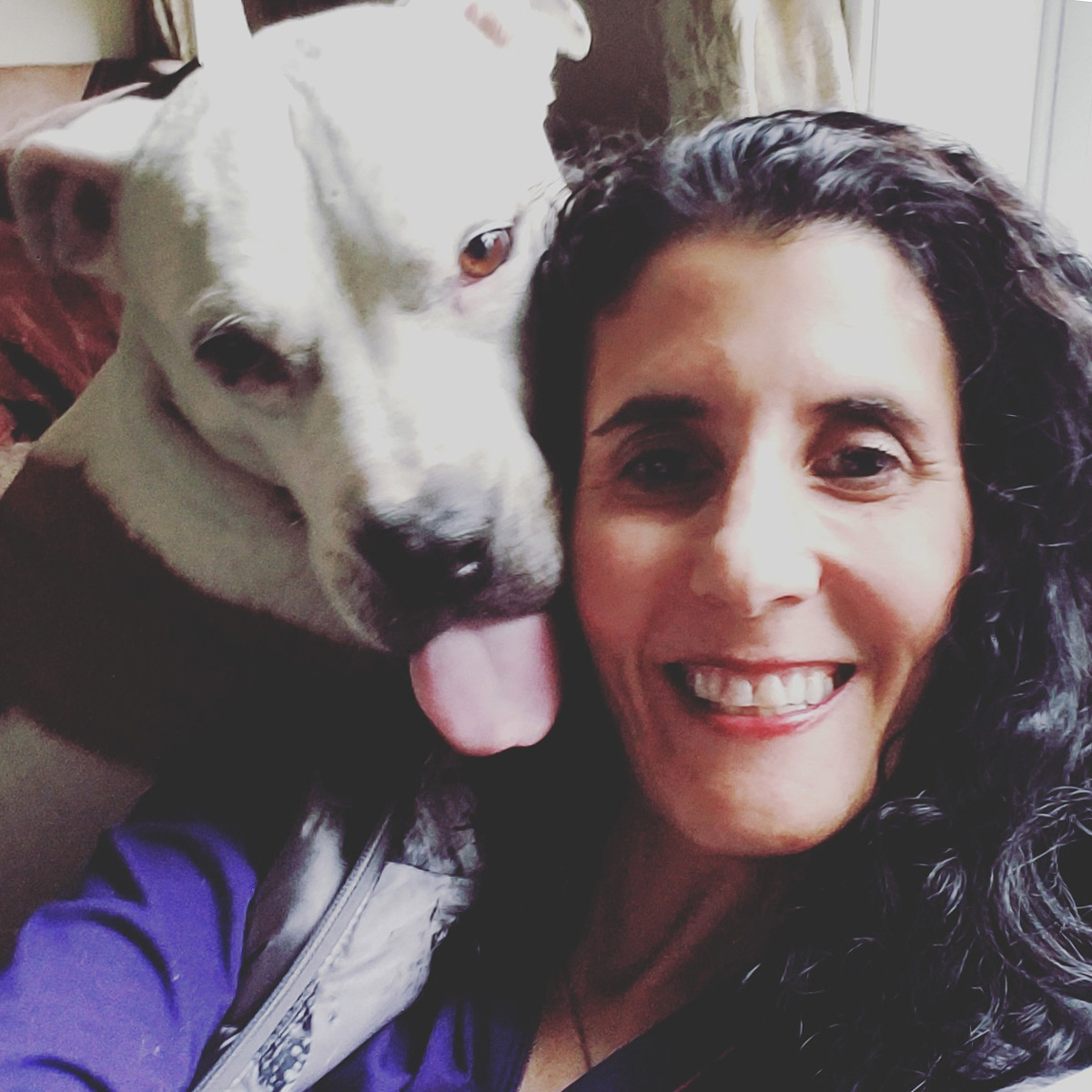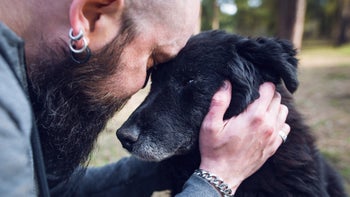
Prozac for Dogs: A Medication to Treat Anxiety Problems
Key takeaways:
Veterinarians use the popular antidepressant medication fluoxetine (Prozac) to treat canine anxiety.
Dogs can take Prozac as a tablet, a capsule, or an oral liquid. It’s usually given to dogs once a day for a long time.
Prozac for dogs is most effective when combined with a behavior modification program. A behavior modification program can help your dog learn new ways to cope with anxiety.
Table of contents

You may have heard of fluoxetine (Prozac), one of the most commonly prescribed human antidepressants. Veterinarians also use Prozac for dog anxiety and other behavioral issues.
Read on to learn more about Prozac and whether it can help your dog manage anxiety.
Prozac for dogs at a glance
Common names | Prozac (fluoxetine, Reconcile) |
What it treats | Anxiety, separation anxiety, aggressive behavior |
How it comes (forms) | Tablets, capsules, oral liquid |
Dosage | Depends on your dog’s weight |
Common side effects | Vomiting, diarrhea, loss of appetite |
Average cost |

How does Prozac for dogs work, and what is it used for?
Prozac belongs to a group of medications called selective serotonin reuptake inhibitors (SSRIs). SSRIs work by increasing the amount of serotonin available in a dog’s brain. Serotonin helps regulate your dog’s mood in ways that can reduce their anxiety.
Save on the top 10 pet medications
Save big on common pet medications like Fluoxetine and Levetiracetam at your local pharmacy.

GoodRx is NOT insurance. GoodRx Health information and resources are reviewed by our editorial staff with medical and healthcare policy and pricing experience. See our editorial policy for more detail. We also provide access to services offered by GoodRx and our partners when we think these services might be useful to our visitors. We may receive compensation when a user decides to leverage these services, but making them available does not influence the medical content our editorial staff provides.
Veterinarians prescribe Prozac for dogs with different types of anxiety. One form of Prozac is FDA approved for dogs as the brand-name medication Reconcile to treat canine separation anxiety.
Veterinarians may also prescribe it off-label for other forms of anxiety. For example, Prozac can help treat some types of aggressive behavior in dogs as well as compulsive behaviors.
What is the typical Prozac dosage for dogs?
A veterinarian will determine your dog’s Prozac dosage based on their body weight. In general, the dosage is 1 mg to 2 mg per kilogram of body weight given once a day.
The table below shows the average dosage of fluoxetine for dogs by weight.
Dog’s body weight in pounds (lbs) | Average Prozac dose in milligrams (mg) |
|---|---|
10 lbs | 5 mg |
20 lbs | 10 mg |
30 lbs | 15 mg |
40 lbs | 20 mg |
50 lbs | 25 mg |
75 lbs | 37.5 mg |
100 lbs | 50 mg |
Your dog’s dosage may vary depending on other health conditions they have, what medications they take, and other factors. A veterinarian will be able to determine the correct amount.
Is Prozac the same for dogs and humans?
When a veterinarian prescribes fluoxetine for your dog, it is the same medication humans take. But human dosages are typically higher than dosages for dogs. A human dosage or the wrong dosage of Prozac could be toxic to dogs.
If you think your dog could benefit from Prozac, speak with a veterinarian. Do not give your dog any medication not specifically prescribed for them. Otherwise, your dog may end up taking a medication or a dosage that is toxic.
Learn more about separation anxiety. If your dog wreaks havoc the minute you leave, we’ve got you covered. Here’s how to manage dog separation anxiety.
Aggression versus fear: Did you know fear is the most common reason dogs show aggression? Learn the ins and outs of dog aggression here.
Signs the problem might be pain: Sometimes, dogs seem anxious when they’re actually in pain. Here are signs your dog is in pain.
How do you give dogs fluoxetine (Prozac)?
Dogs usually take Prozac once a day. Fluoxetine for veterinary use commonly comes in tablets, chewable flavored tablets, or capsules or as an oral liquid. You can give your dog this medication with or without food.
Keep in mind that some dogs may throw up if they take Prozac on an empty stomach. Giving your dog the medication with a treat may help prevent vomiting, which is often a temporary side effect.
But do not give your dog any aged cheese while they are taking Prozac. These types of cheeses can interfere with fluoxetine. A few examples of aged cheese are:
Cheddar
Gouda
Colby
Provolone
Swiss cheese
Read more like this
Explore these related articles, suggested for readers like you.
What should you do if your dog misses a dose of Prozac?
If you forget to give your dog their usual dose of Prozac, give them the medication as soon as you remember. Then give them the medication at the same time you gave the missed dose going forward. Never give your dog two doses of Prozac at the same time to make up for a missed one.
What are the common side effects of Prozac in dogs?
The most common side effects of Prozac in dogs include:
Sleepiness or lack of energy
Shaking or shivering
Restlessness
Excessive panting
Vocalization (whining)
Weight loss
Prozac is considered safe to give to dogs long term. There are no long-term side effects associated with Prozac when it’s given at the recommended dosages. If your dog does experience side effects while they’re being treated with Prozac, tell a veterinarian. They can help you figure out next steps.
Prozac side effects will go away once your dog stops taking the medication. But don’t suddenly stop giving your dog Prozac. A veterinarian will help you taper your dog off the medication to prevent uncomfortable withdrawal side effects.
What are the most serious risks of Prozac for dogs?
Serious side effects in dogs taking Prozac are rare but possible. These side effects require immediate medical attention:
Aggressive behavior
Overexcitement that doesn’t go away
Serotonin syndrome is rare, but your dog could develop it if they take Prozac with another medication that affects serotonin.
Symptoms of serotonin syndrome in dogs include:
Vomiting
Diarrhea
Lack of appetite
Muscle tremors
Enlarged pupils
Fast heart rate
Restlessness
Trouble walking
Being overly hyper or excited
Confusion
Seizures
Which dogs shouldn’t take Prozac?
Dogs with a history of seizures or a seizure disorder should not take Prozac. It also may not be the best option for dogs with diabetes or liver disease.
Tell a veterinarian if your dog has recently worn a flea-and-tick collar or if you plan to have them wear one. Flea and tick collars can interfere with Prozac.
How long does it take Prozac to work for dogs?
It can take up to 60 days for Prozac to work in dogs. But most dogs show improvement in 3 to 4 weeks. You’ll know Prozac is working for your dog when their anxiety-related symptoms start to get better.
Because it takes some time for the medication to build up in a dog’s system, Prozac is most helpful for ongoing issues, like anxiety and compulsive disorders. If your dog has only specific fears about events like thunderstorms or fireworks, Prozac probably won’t be your best option.
Dogs often take Prozac for several months or longer. The medication is most effective when combined with a behavior modification program. In general, severe anxiety can be challenging to overcome with training alone, since anxiety can interfere with learning. The addition of medication can improve a dog’s response to training, raising the chances of long-term behavior change.
How do you know if your dog needs fluoxetine (Prozac)?
A veterinarian can help you determine if your dog will benefit from taking Prozac based on their anxiety symptoms. Common symptoms of anxiety in dogs include:
Destroying items they shouldn’t
Peeing or pooping in inappropriate places inside the home
Avoidance behavior, such as hiding
Excessive yawning, drooling, or licking
Excessive barking or whining
Signs of depression, such as decreased appetite or lack of energy
Pacing or shaking
Restlessness
Showing repetitive or compulsive behaviors, such as chewing or licking
If you notice any of these behaviors in your dog, tell a vet. They can rule out underlying health conditions that can cause these behaviors. They can also evaluate your dog for an anxiety disorder. They’ll decide if your dog might benefit from taking Prozac.
Frequently asked questions
If your dog’s reactivity is caused by fear and anxiety, Prozac may help reduce their reactivity. Reactivity is often a stress response in dogs.
Yes, Prozac can affect a dog’s appetite. Some dogs who take the medication experience digestive side effects, including loss of appetite, vomiting, and diarrhea.
The bottom line
Prozac (fluoxetine) is an antidepressant medication that can be prescribed for dogs with certain types of anxiety and, in some cases, aggression. Prozac is available for dogs as a tablet, capsule, or oral liquid, and it’s usually given once a day. The most common side effects of Prozac in dogs include vomiting, diarrhea, and weight loss. If your dog experiences any of these side effects, giving them Prozac with food may help.
It can take up to 2 months to see improvement from Prozac. But many dogs eventually show improvement in their anxiety symptoms.
Why trust our experts?



References
American College of Veterinary Pharmacists. (n.d.). Fluoxetine.
Brooks, W. (2025). Fluoxetine (Reconcile, Prozac). Veterinary Partner.
Calder, C. (2022). Serotonin syndrome in dogs and cats. Veterinary Partner.
Castel, A. (2025). Psychotropic agents for treatment of animals. Merck Veterinary Manual.
Elanco Animal Health. (2007). Freedom of information summary: Reconcile.
Irimajiri, M., et al. (2009). Randomized, controlled clinical trial of the efficacy of fluoxetine for treatment of compulsive disorders in dogs. Journal of the American Veterinary Medical Association.
Kaur, G., et al. (2016). The use of fluoxetine by veterinarians in dogs and cats: A preliminary survey. Veterinary Record Open.
Marlois, N., et al. (2017). The use of fluoxetine in dogs in veterinary behavior practice: Prevalence of side effects. World Small Animal Veterinary Association Congress Proceedings.
Odore, R., et al. (2020). Behavioral therapy and fluoxetine treatment in aggressive dogs: A case study. Animals.
Reisner, I. (2014). The use of medications in canine behavior therapy. Today’s Veterinary Practice.
Veterinary Place. (n.d.). Prozac for dogs.


























